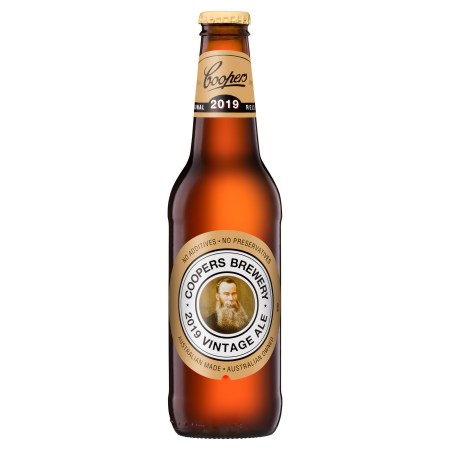
Coopers has launched the 19th edition in its Vintage Ales series.
The beer was made with a single origin malt produced from Compass barley grown in the Murray Mallee in South Australia, and American hop variety Mosaic, which has been paired with Cascade and Centennial.
At a launch event held in Sydney on Tuesday 6 August, Dr Tim Cooper, managing director and chief brewer of Coopers explained the reasoning behind the selection of malt and hops.

“Compass barley is hardy and high yielding, allowing the brew to deliver a hefty alcohol content, yet still retain a fine malt sweetness,” says Dr Cooper. “Judicious blending with a dark crystal malt has given this year’s Vintage its alluring cooper hue and a rich, creamy head.
“This beer drinks well immediately, but will evolve and develop over time, with bitterness levels gradually receding and sweet malt and toffee flavours emerging.
“Last year, Doug Stewart, our maltster, malted Westminster barley from Kangaroo Island. This year, it was decided to take a different variety called Compass from a place called Murray Mallee. It’s an area from the eastern part of South Australia, bordering on Victoria. It’s an important barley-growing area.”
While the barley harvest this year is looking good, last year’s drought were bad for barley growers, which partially drove the decision to choose Compass.
“The Compass barley from the Murray Mallee is it’s a very hardy barley variety so it copes well with dry conditions,” says Dr Cooper. “So a hardy variety and it’s also a high yielding variety. It has a very good extract potential. It’s a good variety to use for Vintage because we get good conversion of the starch to sugars in the brewhouse.”
The Compass barley was malted at Cooper’s new malting facility
“It’s malted in our own maltings of course. So we can select our own barley. We can keep on chasing this concept of local choice of a particular barley, but we can also change the parameters in the maltings to give us slightly characters in the malt. You can use a slightly different process due the germination process and also in the kilning phase as well.
“On the brewing side we also add some Crystal malts and that is to have that nice reddish hue. That’s a traditional colour that we have for the Vintage.”
Coopers Vintage Ales are traditionally driven by hop selection, reflecting the brewing industry’s continuing interest in hops in brewing. The Mosaic hops have been used this year, as part of a growing initiative at Coopers to try and trial as many hops as possible.
“We’re putting a lot more hops into this,” says Dr Cooper. “Each year we change the hop regimen. We’re looking to use a different hop each year. We’ll challenge ourselves each year from around February or March to look out different hops and taste them. We’re getting better and better in terms of selecting these hops and adding them to our beers and tasting the different hops.”
The brewery has introduced in-house hop-tasting sessions where the team try out a range of beers made using different hops. These sessions have been termed ‘Hop Idol’.
“We’ll often do one or two sessions where we’ll taste four or five hops and then another session with another four or five hops and then we’ll taste combinations of the two,” says Dr Cooper. “We’d done a fair bit of experimentation for the XPA as well. This year and last year, we’ve given ourselves quite a lot of opportunities to try out these different hops.
“Mosaic was only introduced in 2012, so it’s been a very popular among the craft brewers in the US. The Mosaic is derived from the Simcoe, which is one that we used in the XPA.”
Like all Coopers ales, the 2019 Vintage Ale undergoes secondary fermentation and natural conditioning. Coopers 2019 Vintage Ale has a 7.5% ABV. It is priced from around $90 per carton or around $30 per six-pack of 355ml bottles.
As well as this launch, Coopers has also put its Sparkling Ale into cans for the first time.

Coopers will release its Sparkling Ale in bright red 375ml cans in mid-August to coincide with the canned release of its new XPA, which has been available on tap in selected outlets since March.
It will bring the number of canned ales in the Coopers line-up to five and comes almost exactly a year after the release of its flagship Original Pale Ale in cans.
“Since we launched Coopers Original Pale Ale in cans, there has been a groundswell from consumers for the release of Sparkling Ale in cans as well,” says Cam Pearce, marketing and innovation director at Coopers. “We listened to the calls and have responded accordingly.”
